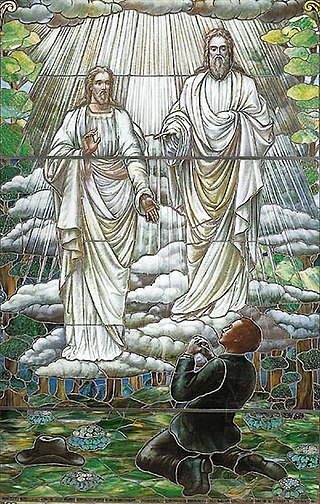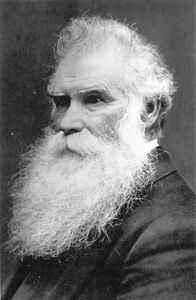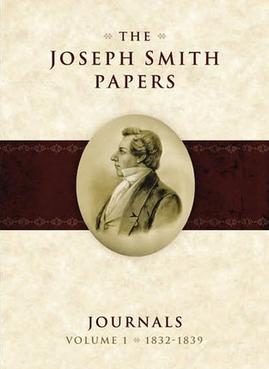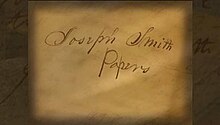The King Follett discourse, or King Follett sermon, was an address delivered in Nauvoo, Illinois, by Joseph Smith, president and founder of the Latter Day Saint movement, on April 7, 1844, less than three months before he was killed by a mob. The discourse was presented to a congregation of about twenty thousand Latter Day Saints at a general conference held shortly after the funeral service of Elder King Follett, who had died on March 9, 1844, of accidental injuries. The sermon is notable for its assertion that God was once a mortal man, and that mortal men and women can become gods through salvation and exaltation. These topics were, and are, controversial, and have received varying opinions and interpretations of what Smith meant. Literary critic Harold Bloom called the sermon "one of the truly remarkable sermons ever preached in America."

The First Vision refers to a theophany which Latter Day Saints believe Joseph Smith experienced in the early 1820s, in a wooded area in Manchester, New York, called the Sacred Grove. Smith described it as a vision in which he received instruction from God the Father and Jesus Christ.

Orson Pratt Sr. was an American religious leader and mathematician who was an original member of the Quorum of the Twelve Apostles of the Church of Christ. He became a member of the Quorum of the Twelve of the Church of Jesus Christ of Latter-day Saints and was a leading Mormon theologian and writer until his death.

The salt sermon was an oration delivered on 17 June 1838 by Sidney Rigdon, then First Counselor in the First Presidency of the Church of Jesus Christ of Latter Day Saints, and frequent spokesman for Joseph Smith, the founder of the Latter Day Saint movement, against church dissenters, including Book of Mormon witnesses Oliver Cowdery, David Whitmer, and John Whitmer, and other leaders including W. W. Phelps. The Salt Sermon is often confused with Rigdon's July 4th oration.
Egbert Bratt Grandin was a printer in Palmyra, New York, best known for publishing the first edition of the Book of Mormon, a sacred text of the churches of the Latter Day Saint movement.

There are many works relating to Joseph Smith. These works cover Joseph Smith's his life, legacy, and teachings. Smith is the author of several works of scripture, and several personal histories, letters, and other writings. There have also been several biographies written about him.

Larry H. Miller was an American businessman. He owned the National Basketball Association's (NBA) Utah Jazz and the Salt Lake Bees, a minor league baseball team. Miller and his companies, now known as the Larry H. Miller Company, also owned more than 60 automotive dealerships throughout the western United States, and a variety of other ventures, including Prestige Financial Services, Jordan Commons, Megaplex Theatres, KJZZ-TV, Miller Motorsports Park, the advertising agency Saxton Horne, and the Delta Center. The Fanzz chain of sports apparel stores was also owned by LHM Group until its sale to Ames Watson Capital in 2018.
History of the Church is a semi-official history of the early Latter Day Saint movement during the lifetime of founder Joseph Smith. It is largely composed of Smith's writings and interpretations and editorial comments by Smith's secretaries, scribes, and after Smith's death, historians of the Church of Jesus Christ of Latter-day Saints. The history was written between 1839 and 1856. Part of it was published in Times and Seasons and other church periodicals. It was later published in its entirety with extensive annotations and edits by B. H. Roberts as part of a seven-volume series beginning in 1902 as History of the Church of Jesus Christ of Latter-day Saints.
Sylvester Marshall Smith was an early leader in the Latter Day Saint movement and one of the inaugural seven Presidents of the Seventy.

The Joseph Smith Papers is a documentary editing project to collect, research, and publish all documents created by, or under the direction of, Joseph Smith (1805–1844), the founder of the Latter Day Saint movement. Documents are published online alongside transcriptions and annotations, with selections also published in 27 printed volumes.
Ronald Kent Esplin is the managing editor of The Joseph Smith Papers project and the former director of the Joseph Fielding Smith Institute for Latter-day Saint History at Brigham Young University (BYU).
Dean Cornell Jessee is a historian of the early Latter Day Saint movement and leading expert on the writings of Joseph Smith Jr.
James Brown Allen was an American historian of Mormonism and was an official Assistant Church Historian of the Church of Jesus Christ of Latter-day Saints from 1972 to 1979. While working as Assistant Church Historian, he co-authored The Story of the Latter-day Saints with Glen Leonard. After Ezra Taft Benson dismissed the book as secular new history, other events led to the dissolution of the LDS Church History department in 1982. Allen resigned as Assistant Church Historian in 1979, returning to work at Brigham Young University (BYU) full-time.
Mark Roscoe Ashurst-McGee is an American historian of the Latter Day Saint movement and editor for the Joseph Smith Papers project.
Mormon studies is the interdisciplinary academic study of the beliefs, practices, history and culture of individuals and denominations belonging to the Latter Day Saint movement, a religious movement associated with the Book of Mormon, though not all churches and members of the Latter Day Saint movement identify with the terms Mormon or Mormonism. Denominations of the Latter Day Saint movement include the Church of Jesus Christ of Latter-day Saints, by far the largest, as well as the Community of Christ (CoC) and other smaller groups, include some categorized under the umbrella term Mormon fundamentalism.
This is a bibliography of works on the Latter Day Saint movement.

The Greek Psalter Incident was a moment in the early history of the Latter Day Saint movement when Henry Caswall reported to have asked Joseph Smith to translate an old Greek psalter he had in his possession on April 19, 1842, in Nauvoo, Illinois, United States. Before meeting with Smith, Caswall was already aware of the psalter's contents and intended to use the request as a means of exposing Smith as a fraud.

Eyewitness accounts associated with the Joseph Smith Papyri have been analyzed extensively to understanding the content, purpose and meaning of the Book of Abraham, a canonized text of the Latter Day Saint movement. In 1835, Joseph Smith, founder of the Latter Day Saint movement, came into possession of four mummies, two papyrus rolls, and various papyrus fragments, which Smith said contained the writings of the ancient biblical patriarchs Abraham and Joseph.








